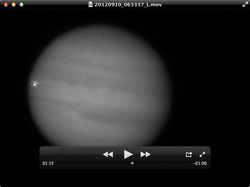Caught on webcam by amateur astronomer George Hall in Dallas, Texas, the impact on Jupiter that occurred yesterday at 6:35 a.m. CT can be clearly seen in the brief video above as a bright flash along the giant planet’s left side.
According to Hall on his website the video was captured with a 12″ LX200GPS, 3x Televue Barlow, and Point Grey Flea 3 camera using Astro IIDC software.
Great catch, George! Currently this is the only video footage we’ve seen of this particular event. Also, tonight at 10 p.m. ET / 7 p.m. PT the SLOOH Space Camera site will broadcast a live viewing of Jupiter to search for any remaining evidence of an impact. Tune in here.
Video © George Hall. All rights reserved, used with permission.


Awesome!
Sa-WEET! Is that in real-time?
The last moment in the video seems to show a black mark emerging around the limb at the impact site? If so, I hope it gets big enough to see in my 4″! Yassir!
No bruise this morning…..* Jupiter must’ve swallered that sucker whole? GULP! Or maybe the impacting object was something a little more ‘exotic’? Something that was instantly vaporized? Like a chunk of ‘mirror matter’? Here’s an interesting link chatting this topic as a ‘dark matter’ candidate. From Technology Review on April 26, 2010:
http://www.technologyreview.com/view/418687/first-evidence-that-mirror-matter-may-fill-the/
Mirror, Mirror, on the wall… Did opposed chirality burn et all? There are plenty of anecdotal data to support meteoric explosions which completely vaporize the parent body.. no dust, no stones or other. Evidence of their passage therefore rare, except for evidence of electromagnetic pulse(s) and supersonic shock waves patterns. Tungusta comes to mind? The rumored impactor of +/-14,000 bp over Northern Canada? Here is a report from Jordan that I found interesting?
http://www.jas.org.jo/mett.html
just how BIG was the impact? Jupiter is massive and that, being so clear must be enormous!
Amazing! Cant believe someone caught this on video… must be the amateur astronomy catch of the decade!
Well, there was this from June 2010: http://wp.me/pru7J-xr (Different decade, I suppose!)
That is truly amazing. It appears we’re entering an era when such sights will be considered routine. 🙂
That can’t be in real time can it ?
Has anyone confirmed this? The flash of light looks … odd, like it’s more in-focus than the rest of the video.
The patterns you see are called an Airy Disk. The part of light that acts like a wave sets up a bull’s eye interference pattern when you push it through a circular aperture like the end of a telescope. Pretty much any telescope will show them if you use very high magnification or defocus it a little.
DAAAAMN SON THAT’S A BIG ASS EXPLOSION.
Wow, amazing that somebody actually got this on video. It’s like finding a needle in a gas giant.
excellent.
I’m sorry, but that doesn’t look like an impact, to me, at all. It looks like some sort of plasma discharge.
Maybe so in your “Electric Universe” wet dream.